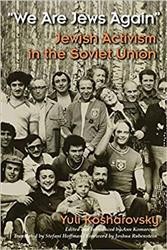
Ann Komaromi, the editor of “We Are Jews Again”: Jewish Activism in the Soviet Union, has been blogging here all week for Jewish Book Council’s Visiting Scribe series.

Photo Caption: Cover Photo. Refuseniks celebrate Succot with Israeli sportsmen in Lunts Meadow outside Moscow, 1975. First row, seated, from left: Anatoly Sharansky, Zeev Shakhnovsky, Ephraim Rosenstein (child), Yuli Kosharovsky. Second row: Isakhar Aharoni, Michael Bronstein, Menachem Berkowitz, Shlomo Fried. Back row, standing: Rami Miron, unidentified, Solomon Stolyar, Zeev Rom, Vladimir Slepak, Maria Slepak, Vitaly Rubin, Lev Gendin, Oksana Iablonsky.
This 1975 photo, used on the cover of “We Are Jews Again”, shows noted refusenik activists Anatoly (Natan) Sharansky, Yuli Kosharovsky, Vladimir and Maria (Masha) Slepak and Vitaly Rubin along with a number of Israeli wrestlers and weightlifters who came to visit the Soviet Union and spent time with Soviet Jews. The photo acts as a window onto one of the brightest moments of Jewish life at that time. The smiles and relaxed poses of the people shown here – notice the way Masha Slepak leans her head familiarly onto Zeev Rom’s shoulder! – suggest that informal Jewish life in the Soviet Union was animated by happy social events and that it benefited from mutual support among members of the community and the friendship of allies from abroad. Unofficial Jewish life was warm and supportive in those ways, but such events took place under the malevolent gaze of KGB officers, who were certainly keeping an eye on this gathering. The possibility of persecution always haunted those involved in unofficial activities. Not too long after this celebration, in March, 1977, Sharansky, would be arrested on false charges of spying and imprisoned for nine years. The police would arrest the Slepaks in June, 1978, after they unfurled a banner from their apartment balcony with the demand for the right to leave and join their son in Israel. For that action the Slepaks were sent to Siberia. The Slepaks were able to leave the Soviet Union, like many of the activists, only after perestroika was well established, in 1987. Those were far from the first arrests for “Zionist” activity, and that hostile environment gives this seemingly ordinary moment the aura of the extraordinary.
People risked coming out with their families for unofficial Jewish celebrations, and foreign visitors made the long journey to see fellow Jews in the Soviet Union and bring them messages of encouragement and support. Such extraordinary efforts resulted in a profound feeling of solidarity and deep ties among people. Recently, work on identifying the people in the photo underscored the tenacity of connections created at that time. Enid Wurtman, a former American activist for Soviet Jewry and a research assistant working with Yuli Kosharovsky on “We Are Jews Again” since 2003, went to great lengths to identify and contact the people shown in this photograph. Enid located Solomon Stolyar, shown here in the back row, who is today head of the Israel Wrestling Federation. He helped put her in touch with the Israeli athletes who had been in Lunts Meadow on that fall day more than 30 years ago. Then-child Ephraim Rosenstein, seated at front with Yuli Kosharovsky, turned out to have been the bar-mitzvah “twin” for Enid’s son in Israel. Bar-mitzvah “twinning” was a common means for raising awareness of the plight of Soviet Jews who could not provide their children with that kind of celebration. In addition, Oksana Iablonsky (also spelled Oxana Yablonsky), standing on the right, was identified by Enid’s friend, Shoshana Fain, widow of the refusenik leader Benjamin Fain. Oksana, it turned out, is an acclaimed pianist who like Enid and like many other refuseniks made aliya to Israel. She played in a Chamber Music Festival in Eilat which Enid’s other son was involved organizing. There was something magical about the connections created and sustained for so many years over the course of this history of the struggle for the freedom of Soviet Jews.
The warm support and enthusiasm of all those contacted about the publication of Yuli Kosharovsky’s history of the movement testify to what that movement has meant to Jews both inside and outside the USSR.
Check back tomorrow for Ann Komaromi’s final post for the Visiting Scribe series.
Ann Komaromi is Associate Professor in the Centre for Comparative Literature at the University of Toronto. She is author of a book on underground novels in the Soviet Union, Uncensored: Samizdat Novels and the Quest for Autonomy in Soviet Dissidence (Northwestern University Press, 2015), which won the AATSEEL Award for Best Book in Literary/Cultural Studies. In 2015, she created the electronic archive “Project for the Study of Dissidence and Samizdat” for the University of Toronto Library Collections.



